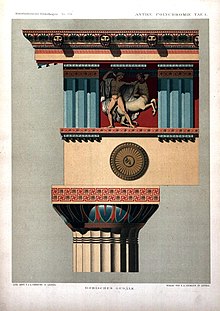This article needs additional citations for verification. (August 2009) |

Polychrome is the "practice of decorating architectural elements, sculpture, etc., in a variety of colors."[1] The term is used to refer to certain styles of architecture, pottery, or sculpture in multiple colors.
When looking at artworks and architecture from antiquity and the European Middle Ages, people tend to believe that they were monochrome. In reality, the pre-Renaissance past was full of colour, and all the Greco-Roman sculptures and Gothic cathedrals, that are now white, beige, or grey, were initially painted in bright colours. As André Malraux stated: "Athens was never white but her statues, bereft of color, have conditioned the artistic sensibilities of Europe [...] the whole past has reached us colorless."[2] Polychrome was and is a practice not limited only to the Western world. Non-Western artworks, like Chinese temples, Oceanian Uli figures, or Maya ceramic vases, were also decorated with colours.
- ^ Harris, Cyril M., ed. Illustrated Dictionary of Historic Architecture, Dover Publications, New York, c. 1977, 1983 edition
- ^ Vinzenz Brinkmann, Renée Dreyfus, Ulrike Koch-Brinkmann, John Camp, Heinrich Piening, Oliver Primavesi (2017). GODS IN COLOR Polychromy in the Ancient World. Fine Arts Museums of San Francisco and DelMonico Books. p. 65. ISBN 978-3-7913-5707-2.
{{cite book}}: CS1 maint: multiple names: authors list (link)